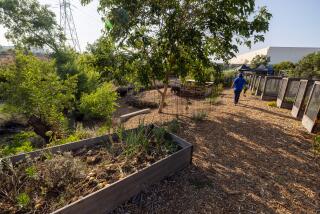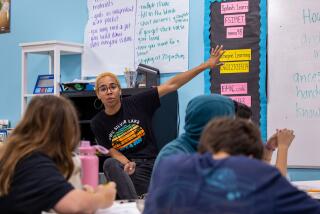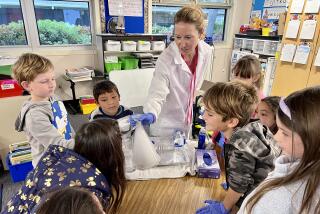Kids Warm Up to Innovative Class on Polar Regions
Polar bears don’t eat penguins, and young Connie Grande knows why.
Connie and her sixth-grade classmates at Beachy Avenue Elementary School in Pacoima are learning about the Earth’s polar regions through an innovative program developed by the Los Angeles Unified School District. The program is being introduced in local schools this fall.
The curriculum, which has been in the making for five years, is one of the few in the nation that deals with the science and social studies, even the politics, of both the Arctic and the little understood continent of Antarctica. The new program also reflects the growing belief that the best way to teach science, especially to elementary-school children, is to allow them to make their own discoveries while doing experiments.
In the process children learn why polar bears don’t eat penguins: Not because the bears don’t like the taste of penguins, not because the bears can’t outrun penguins, but because polar bears and penguins literally live poles apart.
“Before we started,” Connie Grande said, “I thought the Arctic and the Antarctic were exactly the same. Now I know they are completely different except they’re both cold.”
Nationally Recognized
The curriculum was recently selected as one of the 12 best elementary-school science and mathematics programs in a national search funded by the National Science Foundation.
“They really had the elementary-school child in mind when they formulated this unit,” said teacher Margaret Evans, who pilot-tested the program at Beachy. One of its attractions, she said, is that it includes lessons on creatures children find charismatic.
“There are three animals that children seem to like the most--penguins, whales and dinosaurs,” Evans said.
A variety of penguins and whales are included in the unit. And, fittingly, in an age when youngsters can often say Tyrannosaurus rex before they can pronounce spaghetti, there is a dinosaur as well. Several of the lessons deal with Gondwanaland, the theoretical southern super continent that may have existed more than 200 million years ago. Its denizens included lystrosaurus, a swamp-dwelling reptile whose fossilized remains have been found in Antarctica and elsewhere in the Southern Hemisphere.
According to Sid Sitkoff, Los Angeles Unified’s instructional specialist for science and director of the project, teachers first expressed the need for better materials for teaching about the polar regions. There were bits and pieces in existing textbooks and the occasional TV special, but there was no comprehensive curriculum to help teach about the planet’s frozen frontiers. The district obtained federal and state grants of about $100,000 for the project.
Individuals Interviewed
Six district teachers sat down to develop the new course of study. According to Glenn Braaten, a science teacher at Grover Cleveland High School in Reseda who was on the writing team, the teachers scoured libraries for appropriate material and interviewed individuals who knew the polar regions firsthand.
As lessons were developed, they were checked for accuracy by National Science Foundation staff and other scientists. They were also field-tested in area classrooms. Students who had been taught the polar regions curriculum were compared with students who had not. Tests showed that the new lessons were effective: the children who studied them knew far more about the polar regions than those who studied only the conventional science curriculum.
Through a questionnaire, the project staff also learned that many of the students in the experimental group ran home and excitedly told their families what they were learning about plate tectonics and polar expeditions.
Biologist Arnold Small, who travels to Antarctica every February (during the Antarctic summer) to study Adelie penguins and other polar phenomena, was a scientific adviser to the project. Small, a retired college teacher who lives in Beverly Hills, praised the curriculum for its scientific accuracy and its ability to engage students. “I used it in my courses at Harbor (Community College) and UCLA,” he said.
Evans’ classroom at Beachy is a veritable shrine to the penguin, filled with stuffed toy penguins, pictures of penguins and ceramic penguins, many of them gifts from students. The Chaplinesque birds even appear on her coffee cup.
During a recent lesson, the Pacoima teacher directed her students to “get out our icebergs.” In Antarctica, some icebergs are as big as Connecticut. In Evans’ classroom, the icebergs in question were actually ice cubes. First, the students studied the concept of density. They put pennies in a pill vial and immersed the vial in both salty water and plain water. They discovered that salty water, like that in the oceans, is much denser than freshwater. (They had to add more pennies to the vial to get it to sink in saltwater than they needed to sink the vial in plain water.)
After floating the ice cubes in the same glasses of water, they found that their stand-in icebergs (composed of freshwater like real icebergs) rode much higher in the denser saltwater than in freshwater. “Aurora, what do you observe?” Evans asked.
As the children scrutinized their icebergs, the teacher noted that scientists must be careful to repeat the exact conditions of an experiment if they hope to get comparable results. She reminded the children that H2O is the chemical formula for water. She explained that the prefix “an-” in Antarctica indicates that it is opposite the Arctic. And she told them that, hard as it is to believe, Antarctica is technically a desert because it has so little precipitation.
She also broke the bad news about glaciers. “I hate to disillusion you,” she said, “but glaciers are the dirtiest, ickiest things you’ve ever seen.”
Evans thinks one reason for the class’s fascination with the polar regions is that their own climate is so different. “Especially in California, there are some children who have never seen snow,” she said. While the students contemplated a continent where bitter, 200-m.p.h. winds whip across the glaciers, a classroom fan tried to beat the Valley’s autumn heat.
A champion of hands-on science, Evans noted that as soon as students begin working with ice cubes and other objects they can manipulate, “the language barrier falls.” Many of her students speak Spanish at home. But in the classroom they can see the results of an experiment for themselves, regardless of what language they speak. They also learn the new scientific vocabulary at the same time their classmates do.
Observation seems to make scientific facts more credible, especially when the result is unexpected or counter-intuitive. “We are doing it, instead of reading it,” student Anthony Caoyonan said.
But the big plus of hands-on science is simpler and more powerful than that, according to student Jose Jamir. “It’s much funner,” he said.
Although perfect English language skills are not required, writing is an important part of the polar regions curriculum, Evans said. Students plan a trip to Antarctica and write about what they would bring with them. “If the children know only Spanish, they can write in Spanish,” Evans said. “That way I learn some new vocabulary, like the Spanish for parka .” (The term for an Eskimo-style parka is abrigo de piel con capucha.) As the class came to an end, Evans suggested that the youngsters continue their experiments after school. Try freezing some very salty water at home, she said, and see if it gets hard or stays slushy.
That night, refrigerators in Pacoima were commandeered for polar research.
More to Read
Sign up for Essential California
The most important California stories and recommendations in your inbox every morning.
You may occasionally receive promotional content from the Los Angeles Times.










